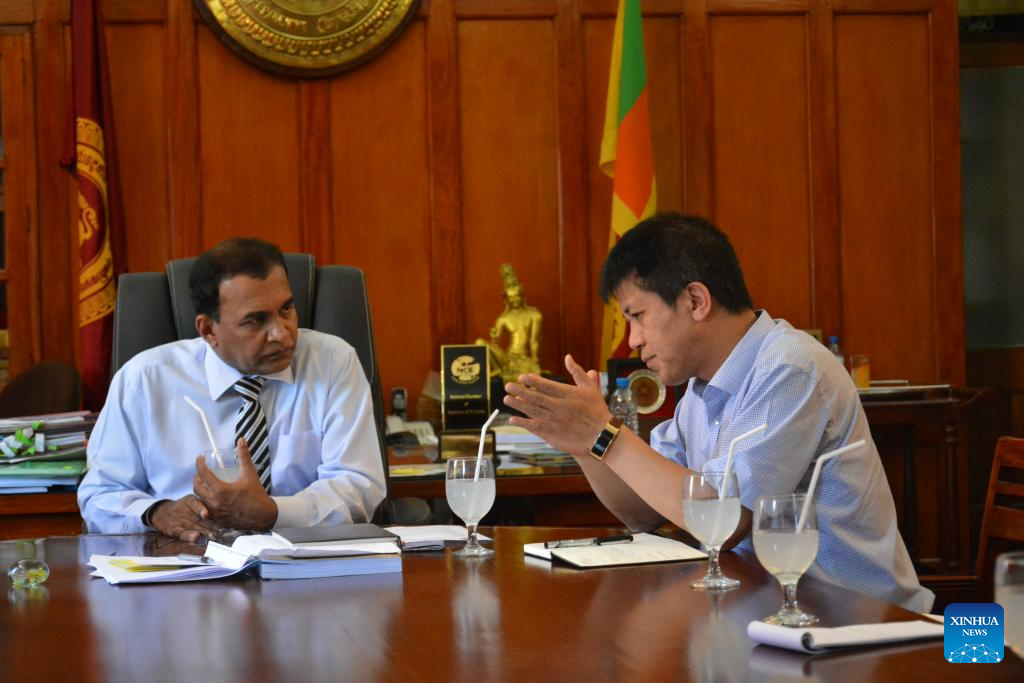Feature: Chinese scientist’s 31 trips in quest for Sri Lankans’ safe water
Posted on October 10th, 2024
Source: Xinhua

A drone photo taken on Sept. 26, 2024 shows the China-Sri Lanka Joint Research and Demonstration Center for Water Technology (JRDC) in the central city of Kandy, Sri Lanka. (Photo by Gayan Sameera/Xinhua)
COLOMBO, Oct. 10 (Xinhua) — In an office drawer of Chinese scientist Wei Yuansong lies a thank-you letter written in Sinhalese and signed off by an entire Sri Lankan village.
The letter, having passed through many hands and franked in various locations, tells shared memories of a decade-long fight against a killer kidney disease that had plagued the locals for years due to a lack of safe drinking water.
“We express our heartfelt gratitude to Professor Wei for providing us with safe and tasty drinking water,” folks from the Nildiya village wrote.
Now serving as the director of the Laboratory of Water Pollution Control Technology at the Chinese Academy of Sciences, Wei told Xinhua that his connection with Sri Lanka began in August 2013, when an email from Doctor S.K.Weragoda asked about water treatment collaboration to address the Chronic Kidney Disease of Unknown Etiology (CKDu) in that country.
At that time, CKDu was a major public health issue in Sri Lanka, with over 40,000 people suffering from it since the mid-1990s, statistics showed. In 2016, then Sri Lankan President Maithripala Sirisena called the disease a “national disaster” that affected 20,828 patients and caused 5,000 deaths per year.
Preliminary research by the World Health Organization indicated a strong correlation between the disease and local groundwater pumped for drinking, and correspondence with Sri Lankan scientists made the issue come into the view of their Chinese counterparts.
In August 2014, Wei made his first travel to Sri Lanka, initiating an arduous research journey together with Weragoda. Each day, they took hours of bumpy road trips deep into the heavily affected areas and paid home visits to villagers for epidemic inquiries.
However, the duo encountered many cold shoulders and doubts. “Many locals thought that the Chinese, like other (foreign researchers), were here to write papers, not to genuinely help them,” Wei recalled. The two scientists had to wade through difficult conversations to win their trust and were eventually welcomed to take samples crucial for their analysis.
Following preliminary research and extensive coordination between Chinese and Sri Lankan partners, a deal was inked in March 2015, enabling joint research on the causes of CKDu and drinking water safety. Since then, Wei frequented Sri Lanka along with more Chinese scientists to conduct thorough research into water treatment solutions that fit local conditions.
Over the following years, the Chinese academy and its partner built four drinking water facilities in Sri Lanka, providing safe drinking water to over 5,000 villagers and more than 1,300 students, followed by a China-Sri Lanka Joint Research and Demonstration Center for Water Technology (JRDC) founded in the central city of Kandy.
The center has since trained more than 30 local medical workers, 20 kidney disease investigators, 20 water professionals, and 30 graduate students. Two joint CKDu-related research papers by Wei’s team won the Sri Lankan President’s Awards for Scientific Research in 2023 and 2024.
“The local people now trust Chinese scientists wholeheartedly … villagers with kidney disease said they no longer go to the hospital for years thanks to the help of Chinese scientists,” said Titus Cooray, a Ph.D. student at the JRDC.
This July, Wei came and attended a China-Sri Lanka joint research workshop at the JRDC themed on climate change, marine sustainability and other topics, with participants from nearly ten countries, including the United States, Canada and the Maldives.
“This is my 31st trip to Sri Lanka. We have laid the foundation from zero to one, and future collaboration will undoubtedly progress from one to infinity,” Wei told Xinhua at the event.
“China has transitioned from being a participant to a leader in global environmental governance, and we aim to bring more benefits to the Sri Lankan people through scientific cooperation and to make this project a model of the ‘Belt and Road’ international cooperation,” he noted. ■

A villager drinks filtered water from a drinking water facility aided by China in Nildiya Village, Sri Lanka, Oct. 2, 2024. (Photo by Gayan Sameera/Xinhua)

This photo taken on Sept. 26, 2024 shows the China-Sri Lanka Joint Research and Demonstration Center for Water Technology (JRDC) in the central city of Kandy, Sri Lanka. (Photo by Gayan Sameera/Xinhua)

Students drink filtered water from a drinking water facility aided by China in Nildiya Village, Sri Lanka, Oct. 2, 2024. (Photo by Gayan Sameera/Xinhua)

This file photo taken on March 22, 2017 shows Wei Yuansong (R), director of the Laboratory of Water Pollution Control Technology at the Chinese Academy of Sciences, visiting Upul B. Dissanayake, then vice chancellor of University of Peradeniya, in Kandy, Sri Lanka. (Xinhua)

A student drinks filtered water from a drinking water facility aided by China in Nildiya Village, Sri Lanka, Oct. 2, 2024. (Photo by Gayan Sameera/Xinhua)

Students fetch filtered water from a drinking water facility aided by China in Nildiya Village, Sri Lanka, Oct. 2, 2024. (Photo by Gayan Sameera/Xinhua)